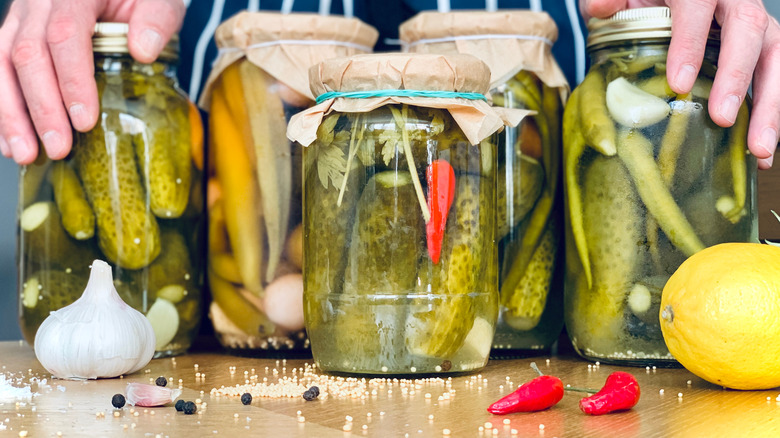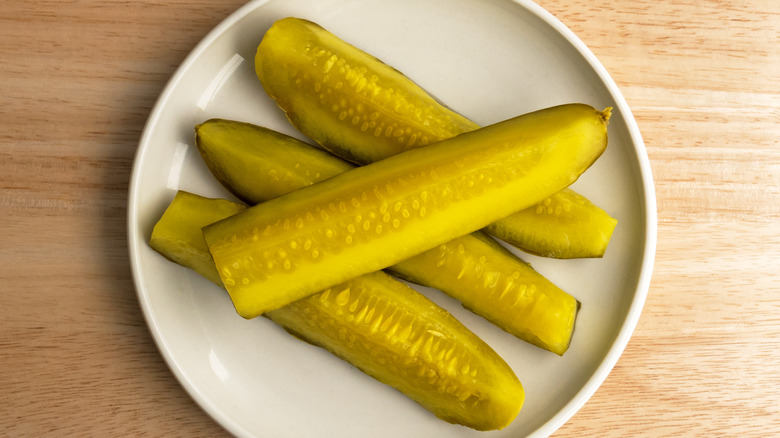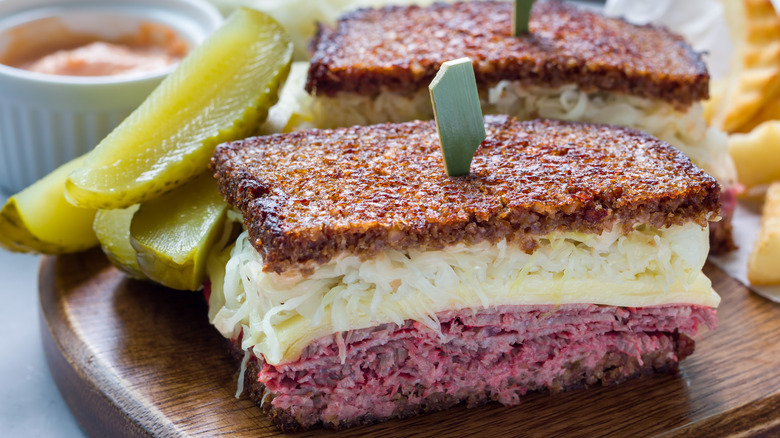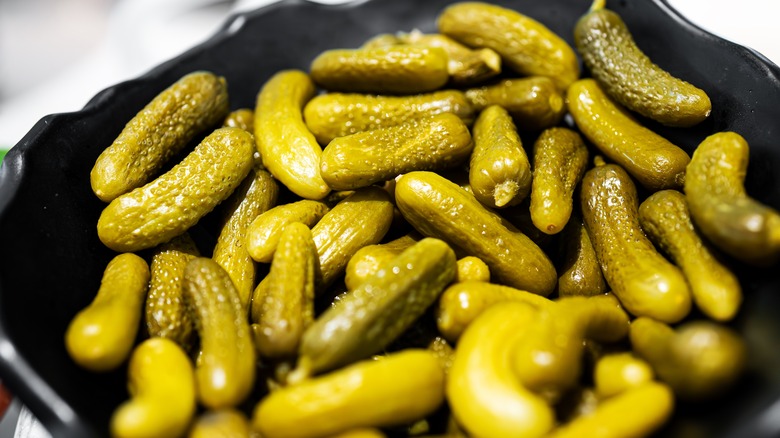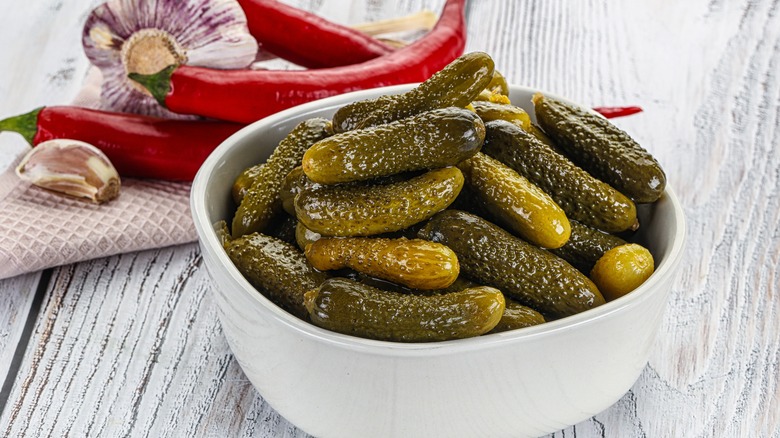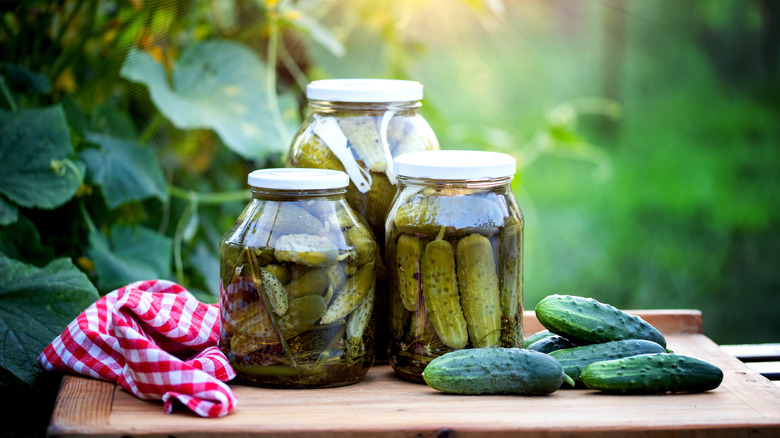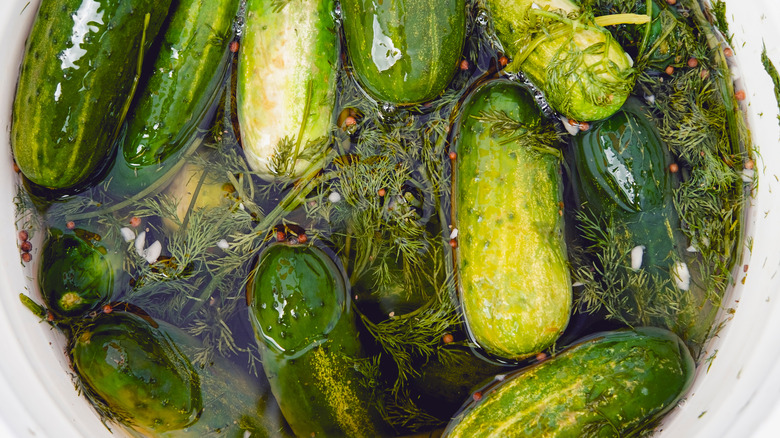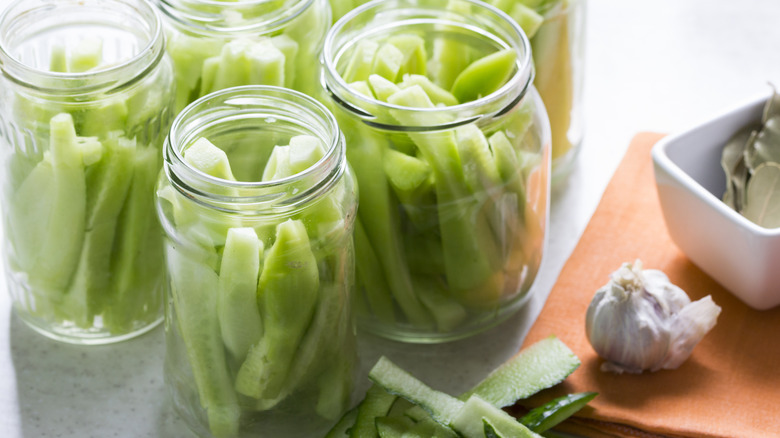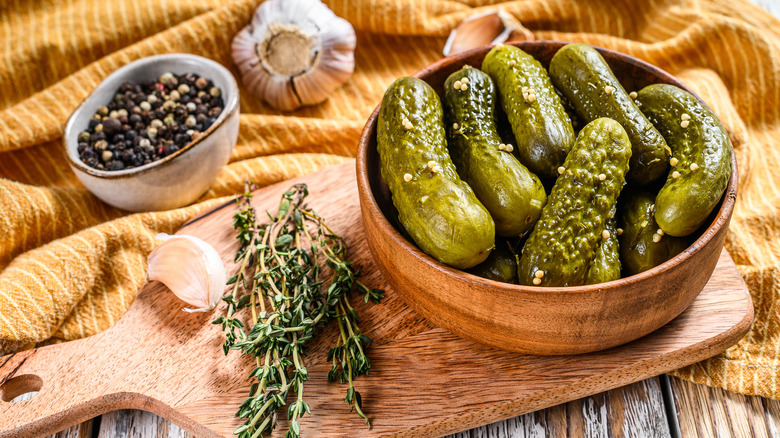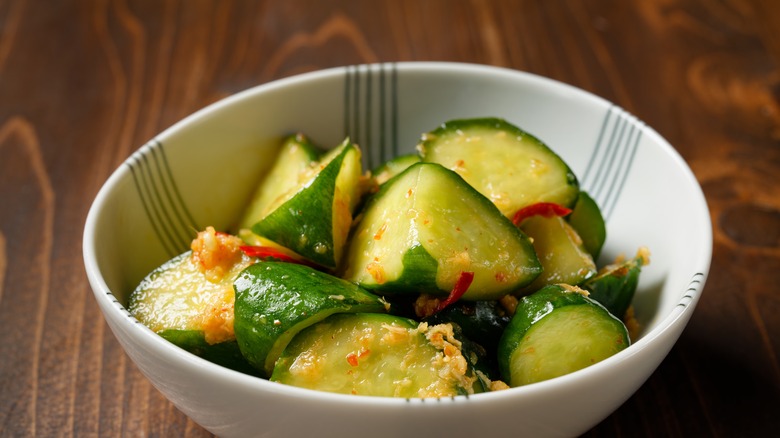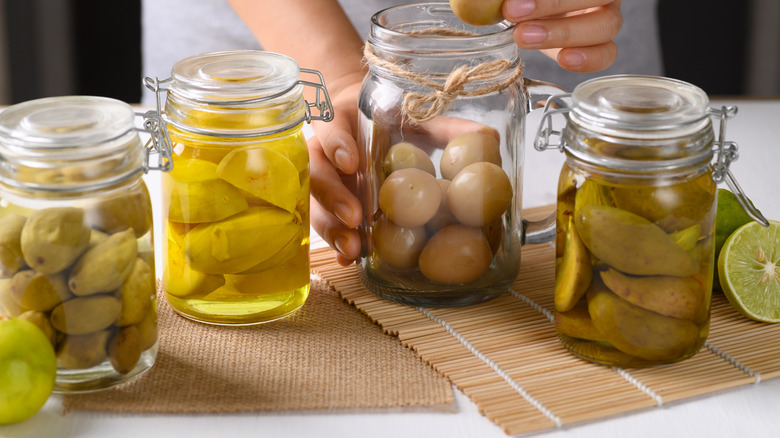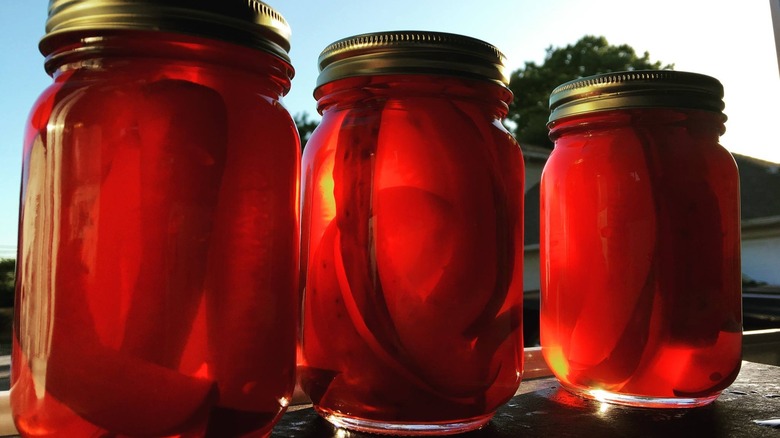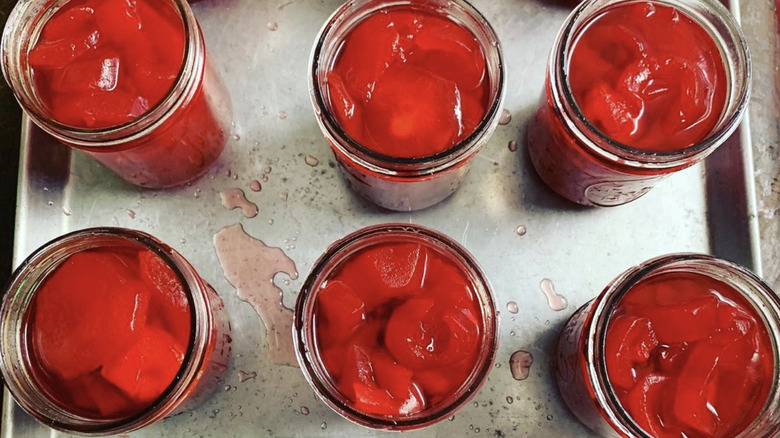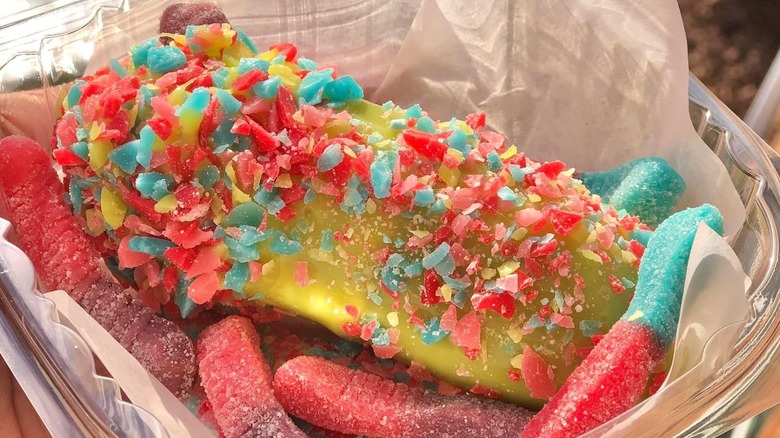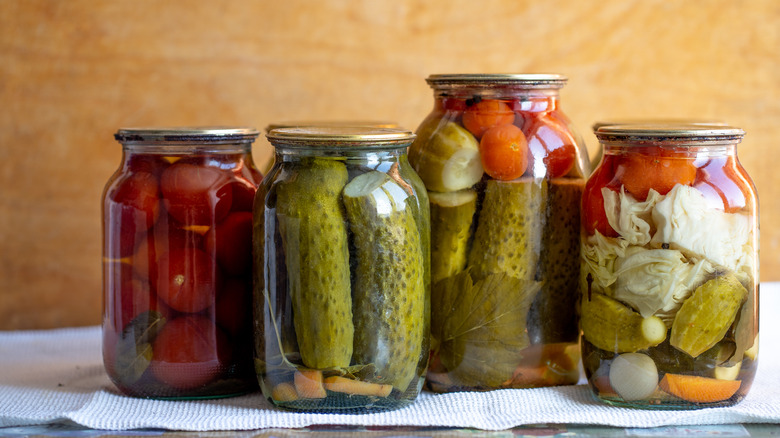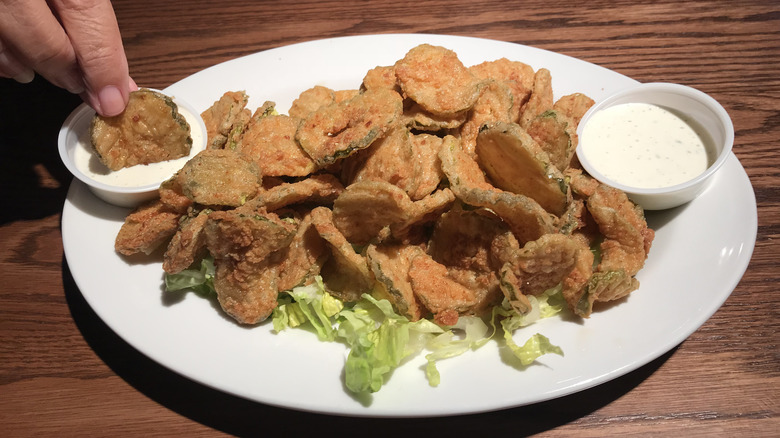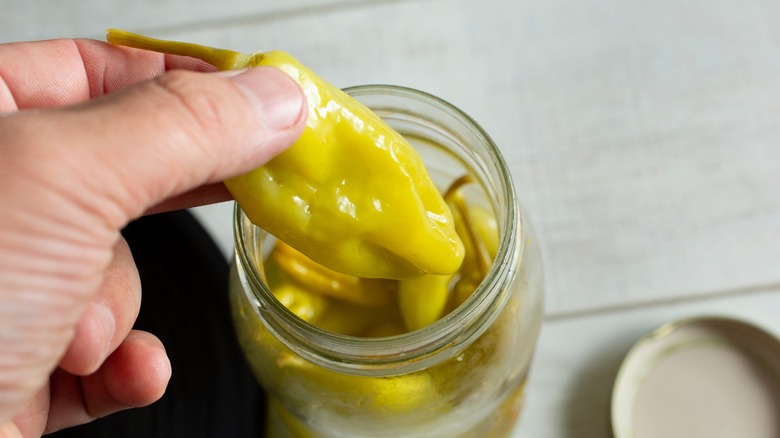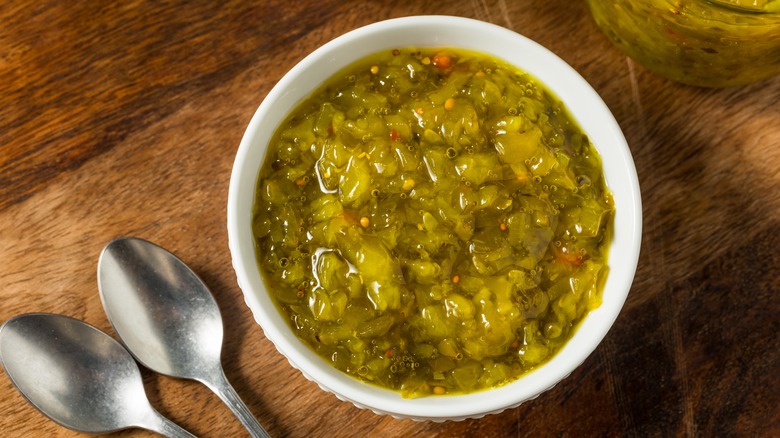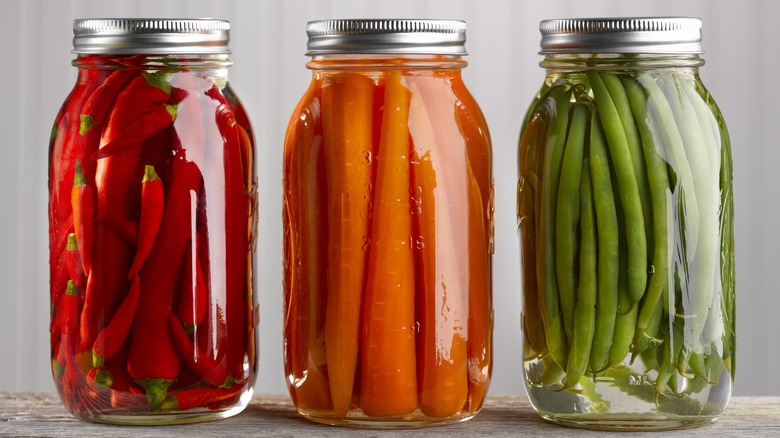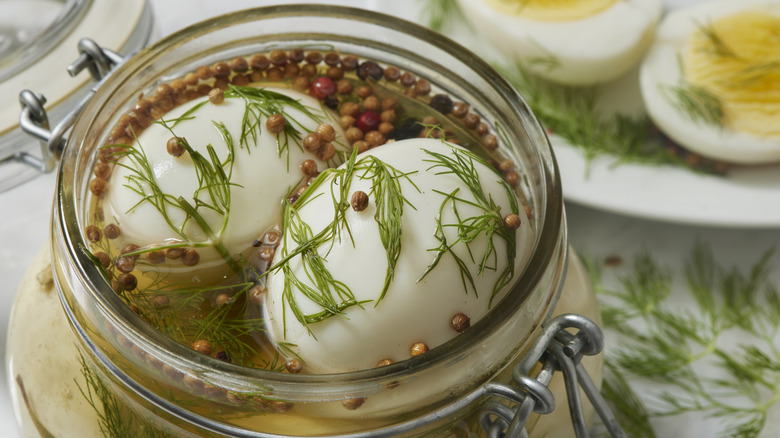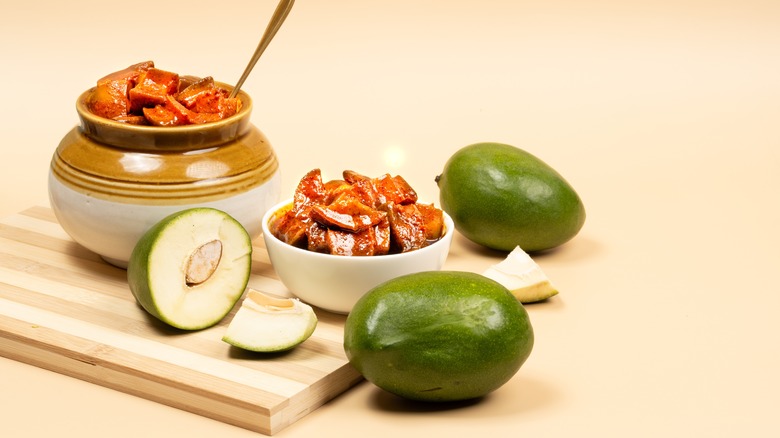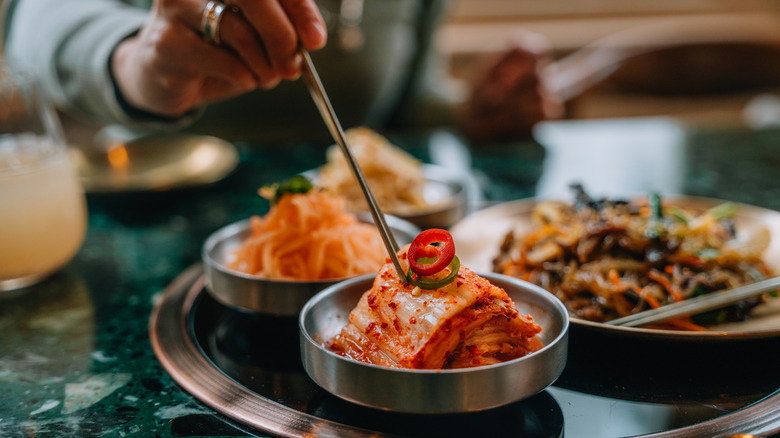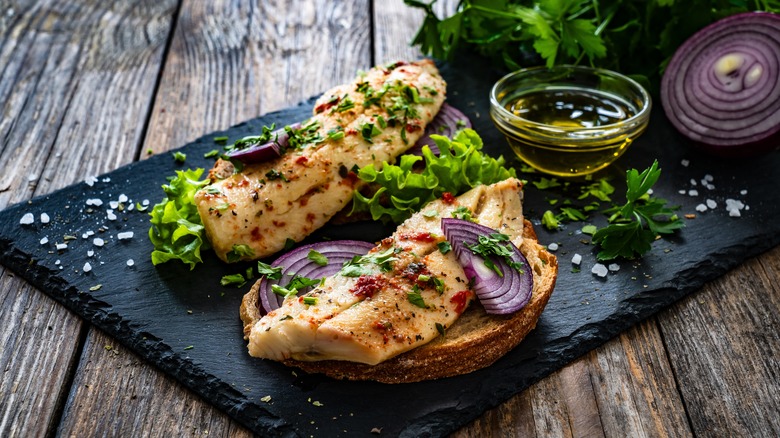23 Different Types Of Pickles And What Makes Them Unique
We may receive a commission on purchases made from links.
If you're a pickle-lover, you probably already have a favorite type of pickle. You're also probably the "Can I have your pickle?" person in your friend group. And you don't go to the store just to get pickles — you go to the store in a singular pursuit of your favorite brand's particular offerings.
Pickles have been around for a long, long time — as far back as 2030 B.C. As a method of preserving food, pickling foods is an extremely important culinary technique. Although there are various types of vegetable pickles worldwide, in America, pickles are dominated by cucumbers, either marinated in a briny liquid or fermented. There are different pickle shapes: chips, spears, wedges, slices, halves, and wholes, all with their respective textures and culinary purposes. While texture is certainly a crucial aspect of pickle enjoyment, so is taste.
There are so many types of pickles, in fact, that we feel the need to compile them into a list. The following pickles are all made in slightly different ways, whether with various spices, vinegars, or cucumbers. Whether you're eating your pickles whole, throwing them on a burger, or chopping them up for recipes, it matters which kind you use, so read on to potentially discover your new favorite pickle!
1. Dill pickles
The genuine dill pickle is the starlet of all pickles — everyone knows her even if they don't like her. Are dill pickles the original pickle? No, but they're likely the most popular pickles around. When you think of a pickle taste, their typically the salty and tart taste of a dill pickle that comes to mind. Jarred, pantry-safe dill pickles are likely made in vinegar-based brine, while the refrigerated versions are made with salt-based brine.
Our dill pickle recipe calls for Kirby cucumbers, which are often referred to as "pickling cucumbers" due to their firm, sturdy crunch and mild flavor. To follow our recipe for dill pickles, submerge quartered Kirby cucumbers in a mixture of water, dill, dill seeds, distilled white vinegar, sugar, kosher salt, coriander seeds, and garlic. If you prefer your pickles whole, plan to let them ferment in the mixture for a few extra days.
2. Kosher pickles
It's common to get dill pickles and kosher dill pickles confused. These are two different types of pickles with distinct ingredients and tastes. First of all, what does kosher mean? Kosher refers to a set of Jewish dietary restrictions. However, kosher pickles aren't necessarily always "kosher" in the sense that they follow the Jewish dietary guidelines.
When it comes to pickling, kosher-friendly salt is coarser and flaky, making the dishes prepared with it less salty-tasting than those made with denser, grainier salt. The biggest difference between dill and kosher dill pickles is not the inclusion of salt but garlic. Since kosher pickles are more garlicky than dill, they taste great on various sandwiches, and when chopped up, they make for a delicious inclusion in tuna salad!
3. Bread and butter pickles
Another world-favorite pickle is the bread and butter pickle. We mostly see these in the form of pickle chips stacked on sandwiches and burgers. As a pickle, bread and butter pickles have a sweeter flavor when compared to dills. This distinctive sweetness is due to the inclusion of sweet onions in the recipe for the pickle marinade along with white vinegar, sugar, salt, mustard seeds, coriander seeds, and celery seeds.
However, it's common for many commercial pickle brands to use high-fructose corn syrup to sweeten the pickles. Major pickle distributor Mt. Olive makes their signature bread and butter pickle chips sweet with high-fructose corn syrup. Bread and butter pickles are so popular that Mt. Olive even makes a sugar-free version of them, sweetened by the inclusion of Splenda. Bread and butter pickle chips are a staple for your classic cheeseburger recipe, or you can serve bread and butter spears as a side dish to offset a super salty meal.
4. Gherkins
The first thing one notices about gherkins is their appearance — they are much smaller than most cucumbers, sizing up at about 1 to 2 inches long with a curved and bumpy shape. Generally, gherkins are pickled with a sweet flavor, although they can also be pickled like standard dill or sour pickles. The texture is the main appeal of gherkins over other larger pickles. Since gherkins are small and have a bumpy surface, they've got a lot more crunch than larger, fleshier cucumbers and pickles.
Gherkins are typically pickled whole rather than sliced into spears, halves, or chips. For this reason, they aren't usually the kind of pickles that you eat on a sandwich or a burger. It's typical to see gherkins on a charcuterie board or as a side garnish at a deli. Of course, they also make a tasty snack all on their own.
5. Cornichons
It's common for people to mistake cornichons and gherkins as interchangeable terms because of their similar appearance, but we'll set the record straight. Cornichons are a bit smaller in size than gherkins and may also be referred to as "French gherkins." Like other pickles, they can be fermented or marinated in a mixture of herbs like dill, tarragon, or pepper.
Cornichon pickles are made with a small-growing variety of gherkins with pronounced tart and salty flavors. Like gherkins, cornichons are commonly found on cheese plates or charcuterie boards, as they add a bit of a palate-cleansing, refreshing bite between creamy cheeses, sweet fruits, and salty meats.
6. Full-sour pickles
When we think of the flavor of any pickle, two words usually come to mind: salty and sour. However, certain pickles are made to be predominantly sour. These can be broken down into two types of pickles: full-sour and half-sour. If you're guessing that full-sour pickles pack more tang per bite than half-sours do, you'd be correct.
As is implied by their names, full-sour pickles are more tart than half-sour pickles. They achieve more of a sharp flavor than half-sour pickles because they are fermented in a salt-based, non-vinegar solution for about 12 to 16 weeks. Sour pickles make great snacks for those who love a tangy bite, but the juice of full-sour pickles can also work well in drinks like pickleback shots. Compared to milder-tasting pickles like dill, the flavor of full-sour pickle juice will provide a more potent recipe for your next pickleback shot.
7. Half-sour pickles
While half-sour pickles are obviously less sour than full-sour pickles, they are still plenty sour. Half-sour pickles are usually fermented for around six to eight weeks. Half-sour pickles tend to pack more of that crisp, satisfying crunch that many people desire from a pickle. Since full-sour pickles soak for double the length of time that half-sours do, they can be a bit soggy and more sour in comparison.
Crisp Kirby cucumbers are a great starter for half-sour pickles. Then, it's often paired with ingredients like fresh garlic, celery seed, dill seed, fennel pollen, dill pollen, fresh dill, mustard seed, and black pepper. Some simpler recipes are made with just garlic cloves, bay leaves, coriander seeds, mustard seeds, black peppercorns, and dill.
8. German pickles
There are a handful of foods that come to mind when we think of German cuisine, like sauerkraut, bratwurst, schnitzel, and mustard. Accordingly, German pickles are called senfgurken, which translates to "mustard pickle" in English. Aside from their unique ingredients, what makes German pickles different from common American ones like dill pickles is that, rather than being fermented whole, the cucumber skin is peeled before it's pickled.
You may be thinking that without the skin of the cucumber, these pickles might be kind of soggy. If left too long in the brine, German pickles might lose their crunch, but removing the cucumber peel allows the brine to saturate the cucumbers more quickly than with other pickles. Therefore, there's no need to worry: Your German pickles will still have a satisfying crunch to them. Taste-wise, German pickles are slightly sweet and sour. You may also see German pickle recipes made with flavorful additions like juniper and allspice berries.
9. Hungarian pickles
When it comes to ingredients, Hungarian pickles are not terribly different from dill pickles or other common pickles. What makes most Hungarian-style pickles unique is that one of the most important steps in making them is to give them ample sun exposure to help them ferment. Hence, they are often called Hungarian sun pickles or Hungarian summer pickles.
Many Hungarian pickles are also made by including bread in the fermentation process. The bread serves several purposes, including preventing air from coming into the bowl and giving it a unique taste. Although including bread isn't always necessary. Some recipes for Hungarian summer dill pickles just have kosher salt, white vinegar, fresh dill, and water. Hungarian pickles can also be made with various household herbs and spices, such as garlic and peppercorns.
10. Hot pickles
Are you the kind of person who simply thinks that everything tastes better spicy? The kind of person who just douses everything they eat in hot sauce? We've got a pickle you're going to love!
If you'd like to make your own hot pickles, there are tons of ways to do so. You can take any regular pickle recipe and add spicy ingredients like cherry peppers, jalapeños, or habanero peppers. For example, try a spicy pickle features a dynamic blend of apple cider vinegar, white vinegar, pickling salt, dried dill weed, Thai red peppers (or hot pepper of your choice), garlic cloves, and a mixture of pickling spices.
Besides homemade recipes, many major pickle brands also make hot pickles. Mt. Olive, one of the most popular pickle brands in America, sells a Buffalo-style kosher dill pickle made with Texas Pete Hot Sauce and a SweetHeat variety of bread and butter chips for those who like things both sweet and spicy. As you're probably already imagining, spicy pickles can make a mouthwateringly zingy addition to sandwiches and burgers. As a bonus, the pickle juice also adds a flavorful kick to marinades and salad dressings.
11. Lime pickles
Despite their name, lime pickles aren't made with lime juice. Instead, the key ingredient is pickling lime, which is actually calcium hydroxide. The pickling lime is used to maintain the pickles' firmness, meaning lime pickles are typically very crunchy.
A great brand to try is Jake & Amos, who states that the inclusion of pickling lime has origins in the "old days of the Pennsylvania Dutch Country." Pickling lime is a chemical that has been used for many things that don't actually involve pickles — or food — at all, such as whitewash or plaster. Of course, the lime used for pickling is a food-grade version of the chemical used for construction. Still, there are health issues with consuming lime. According to Healthline, studies have linked pickling lime to severe illnesses, so many modern recipes tend to nix the ingredient.
12. Kool-Aid pickles
Yup. Kool-Aid pickles exist, and yes, they are made with actual Kool-Aid, the vibrant fruit drinks with the juice pitcher wearing sunglasses as a mascot. When you think of unusual food combinations, fruit punch and pickles are probably one of them, but these pickles are actually quite popular. Historically, it's believed that the Kool-Aid and pickle combo originated in Mississippi, where they cleverly call them "koolickles."
Kool-Aid pickles are made with pickles that are already, well, pickled. That said, Kool-Aid pickles aren't just cucumbers marinated in Kool-Aid. Typically, a jar of whole dill pickles is drained, then the pickles are coated in sugar and an unsweetened Kool-Aid packet. If you allow the pickles to marinate for about a week, they'll end up with a fun, vibrant color. As you might imagine, Kool-Aid pickles taste fairly sweet and tangy, so they make for great snacks on their own.
13. Cinnamon pickles
We've got another unusual food combo for you: cinnamon and pickles. Weirder than Kool-Aid and pickles? Maybe. However, the end result is similar: pickles that taste sweet. Cinnamon pickles get their name from one of their major ingredients: cinnamon red hot candies. You may think that this makes the pickles spicy, but due to the inclusion of sugar, these pickles end up with a cinnamon flavor and an overall sweet taste.
Similar to German pickles, these pickles call for completely peeled cucumbers. To make them, you'll need to create a mixture of cinnamon red hot candies, cinnamon sticks, pickling lime, sugar, distilled white vinegar, red food coloring, and alum. You may also hear these recipes called "Christmas pickles." They are eaten on their own or can be included in crudité platters or relish trays. These pickles are not easily found in stores, so you will likely have to make them yourself if you'd like to try them. Making these pickles is a process that takes around four days, but we think they'll be worth it!
14. Candied pickles
By now, we're used to the whole excessively sweet pickles thing. So, candied pickles shouldn't come as too much of a surprise. If there's a market for candied jalapeños, a market for candied pickles doesn't seem too hard to conceive. When we say "candied," we use the term loosely, as it can mean different things to different people. Most candied pickle recipes are simply recipes for sweet pickles.
For example, many candied pickle recipes can be made with a drained jar of dill pickles and a mixture of cider vinegar, sugar, and pickling spices. Simple enough! However, there are also candied pickle recipes that are far more extravagant and colorful — and made with actual candy. We're talking pickles wrapped in Fruit Roll-Ups. Candied pickles are an example of the boundless creativity that pickle-lovers have when it comes to innovative recipes.
15. Refrigerator pickles
Have you ever realized that when you go to a grocery store, some pickles are sold on shelves with other pantry foods while others are sold in the refrigerated section? This is because pickles that are unpasteurized typically require refrigeration, as refrigerating them slows down the fermentation process so that they don't sour too quickly.
While you can buy refrigerated pickles at the store, it is popular to make refrigerator pickles at home, usually for that time of the year when your garden is simply overflowing with fresh cucumbers. However, you can always use store-bought cucumbers to make your own refrigerator pickles. Since they are fairly easy to make, you can get experimental with ingredients. Try a recipe with sliced onions, sugar, salt, cider vinegar, mustard seed, celery seed, and cloves. These pickles make for an ideal at-home snack, especially since they are super low in calories and nutrient-rich, with various vitamins and minerals and numerous digestive health properties.
16. Fried pickles
Fried pickles may have started off as a gimmick, but the surprising experience of eating a warm and sour pickle wrapped in crisp, golden breading has turned the dish into a state fair and gastropub mainstay. Heck, you can even find them in the freezer aisle!
Fried pickles got their start in the 1960s in Arkansas, when Bernell Austin, an aspiring restaurateur, leased land across the street from the Atkins Pickle Company. Austin began frying pickles in 1963 as a way to tempt passerbys to stop at his drive-in. The dish soon became a local sensation.
Austin opted for pickle spears, which he breaded and deep-fried before serving. Whether you're using spears or slices, the key to a great fried pickle is all in the breading. Remember to dredge your pickles in flour before either dipping them in batter or dunking them in liquid and a final breadcrumb coating. It will help the crisp exterior adhere to the moist pickle, in turn creating a crispy shell around this super satisfying snack. Play around with pickle shapes and thickness to find the perfect pickle-to-crust ratio, and don't forget to whip up a dip. Might we suggest spicy mayo?
17. Pickled peppers
Peter Piper picked a peck of pickled peppers, but all you need to do is head to the pickle aisle of your grocery store to get a jar of them. There, you'll find a plethora of options ranging from sweet biquinhos (aka sweety drops) and bright banana peppers to fiery sport peppers.
Just like with cucumbers or other vegetables, pickling peppers (hot or not) involves submerging the peppers in a vinegar brine. You can add other flavors, like herbs or garlic, or just let the heat really shine. Speaking of heat, all that time in a vinegar bath does ease the spice just a bit, as some of the capsaicin escapes into the brine during the pickling process. And, just like when pickling cucumbers, the crisp and fresh flavor of the flesh is replaced with something a bit more tender — all packed with an acidic zip on the palate.
Pickled peppers are at home just about anywhere. Scatter pepperoncini on an antipasti platter, layer sliced banana peppers into your sandwich, tuck a sport pepper into your hot dog, or top a platter of nachos with pickled jalapeños. Pickled peppers are also right at home in everyone's favorite brunch cocktail, a bloody mary. Add some brine to your glass and a pepper to your garnish skewer to really wake up your weekend morning.
18. Sweet pickles
While a bread and butter pickle is definitely more mild than its saltier, more sour cousins, it's not the sweetest pickle on the block. Enter the sweet pickle.
Sweetener, cinnamon, and cloves find their way into the brine for a crispy cuke that's a far cry from puckering full-sours. Just don't expect a sweet pickle to taste like dessert. There's still plenty of vinegar and salt to be had. Sweet pickles are different than bread and butter pickles because they don't use savory spices. Coriander, mustard seeds, and celery seeds (in addition to sugar) are common for bread and butters, which puts their flavor somewhere between a sweet pickle and a kosher dill.
But back to sweet pickles. They're a great type of pickle for snacking right out of the jar, especially if you're not a sour pickle fiend. They're also a key ingredient in pickle relish. Squeeze some wildly green relish onto a hot dog, garnish deviled eggs with it, or add it to your next grilled cheese to cut through the richness with a bright bite.
19. Pickled veggies
There's so much more to the world of pickles than just cucumbers. Pickling is an age-old preservation technique used for all sorts of fruits and vegetables — items that would otherwise spoil during prolonged storage. Pickling allows them to become a delicious and year-round food source.
The garden is your playground when it comes to types of vegetables you can (and should) pickle. Firm spears of asparagus, green beans, and carrots are reminiscent of cucumber pickle spears, and are equally delicious. They soften slightly, though are still crunchy and snackable — which makes them a great type of pickle to use for a bloody mary.
For a pickley addition to a salad or succotash, grab some beets, radish, and corn. Pickling beets build on the root's natural sweetness. This sweetness meshes well with the subtle tang, making for a perfect addition to a sandwich or a salad. Pickling tempers some of the radish's sharp bitterness and bite, while pickled corn kernels are the garnish you didn't know you needed for tacos and salads. The process pairs the sweetness of the corn with acidic vinegar (and maybe some chilis if you're feeling fiery).
Don't overlook those onions hiding in the bottom of your jar of cornichons. Pickled pearl onions belong on your charcuterie board, as well as in your next cocktail — they are the star of a Gibson martini, after all.
20. Pickled eggs
The preservation powers of pickling works on more than just vegetables. It can be used to make a plethora of foods last longer, including eggs. Pickled eggs date back to pre-colonial days; they were even brought by Pilgrims on the Mayflower. They have also enjoyed popularity as a bar snack; the spices and aromatics transform humble hard-boiled eggs into a briny, savory treat.
After a few weeks in a vinegar-based solution, pickled eggs taste like, well, pickles. The white absorbs the flavors of the vinegar and any other ingredients added to the brine, while the yolk provides some creamy contrast. If you follow a German-style pickled egg recipe, you'll wind up with something that tastes a lot like sauerkraut. For a hint of sweetness and a pop of color, you can add beets to the brine (which also leaves you with pickled beets). Use red cabbage for a striking blue-purple color, or turn to mustard powder or turmeric for eggs that are bright yellow.
To maintain their freshness, pickled eggs need to be kept refrigerated and fully submerged in the brine. They'll keep for three to four months, though it's important to remember that the flavor will be stronger than if you eat them after the first week or two.
21. Pickled fruit
If your favorite thing about pickles is the sour tang, you'll love pickled fruit. The combination of sweet fruit and sour brine turns things like strawberries, peaches, and mango into a new treat. Plus, the method allows you to preserve the summer's bounty.
The addition of vinegar to the fruit preservation equation helps maintain tart flavors that would otherwise be lost in traditional canning. Pickled peaches, for example, are made with vinegar, which makes them a great choice for salad and cocktails — not just pie filling.
Pickling can also make the most of under-ripe produce, as it can transform it into a more savory snack. Strawberries are a great choice for pickling, as the berries are firm and won't totally dissolve as they pickle. Green strawberries are definitely more vegetal in flavor (which makes them great for a cheese board), while ripe red strawberries pickled in red wine vinegar have a mouthwatering depth of flavor and a recognizable sweetness. If your fresh strawberries look better than they taste, turn to pickling to maximize what you have.
If you're a fan of Indian cuisine, pickled mango is likely a familiar addition to your meal. Aam ka achaar, the spicy and tart pickle made from green mango, is a must-have. Eat it on its own, with rice or your favorite flatbread, or alongside rich stews to brighten your palate.
22. Pickled sides and condiments
A plate of artisan cheeses and cured meats isn't the same without pickles, and we don't mean just cornichons. Pickled mustard seeds will brighten up your next bite of country pâté with a mustardy, salty pop reminiscent of a fine caviar. Snack on pickled walnuts between cheeses to refresh your palate. Don't forget the relish (we suggest Branston pickle) next time you're serving an aged cheddar.
Chicago is home to two must-know pickled condiments: relish (bright green, of course), and giardiniera. Giardiniera is a combination of chunky pickled vegetables — cauliflower, carrots, celery, and peppers or olives — in vinegar and olive oil. It's arguably the best type of pickle to add to an Italian beef sandwich.
You can't talk about pickled sides without mentioning kimchi and sauerkraut. Kimchi is probably the best-known banchan, or side dish, in Korean cuisine. Layers of cabbage leaves are spread with a mixture of chili flakes, garlic, and other aromatics before being fermented. It's spicy, a little funky, and good on just about anything.
Sauerkraut is sliced or shredded cabbage preserved with salt. It is sometimes seasoned with spices like fennel, caraway, or mustard seeds and it doesn't ferment as long as kimchi. You really can't go wrong with it, whether you fold it into pierogis, layer it on a sandwich, or add it to braised sausages.
23. Pickled meat and seafood
Pickling preserves meat and seafood just as well as fruits and vegetables. It turns something that would spoil easily into a tasty food that will last through long voyages or, in modern times, until it's ready to hit the table.
Even with widespread refrigeration, some pickled proteins are too tasty to let them fade into history. Corned beef is one such food; it's a St. Patrick's Day must as well as the star of a towering reuben sandwich. A tough piece of brisket is technically cured in salt brine with pickling spices (sound familiar?) so it transforms into something tender, succulent, and highly sought-after.
Pork products are also prime for pickling. Pigs feet are a Southern classic; they're boiled until tender before being brined to add that tangy flavor to the collagen and gelatin. You might also see pickled ham hocks, which are also called pork knuckles.
For something a little lighter, turn to pickled seafood. Pickled herring is a common type of commercially-available pickled fish that's soft and flaky. The fatty flesh easily absorbs flavors ranging from dill and mustard seeds to curry and cream. Pickled shrimp are also a Southern favorite that pairs the sweet and tender crustacean with an aromatic brine. And unlike other pickled foods, the process of pickling shrimp only takes a few hours. Just remember that this is about flavor, not long-term preservation, so pickled shrimp should be eaten within a week.
